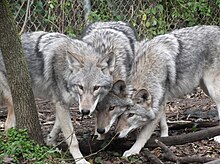Coywolf
Coywolf (sometimes called woyote in the US) is an informal term for a canid hybrid descended from coyotes and gray wolves . All members of the genus Canis are genetically closely related and can interbreed as they have 78 chromosomes. A genetic study shows that these two species separated genetically relatively recently (around 55,000–117,000 years ago). Genomic studies suggest that almost all North American wolf populations have some degree of intermingling with coyotes that follow a geographic cline , with the lowest values in Alaska and the highest in Ontario and Quebec, as well as the Atlantic provinces of Canada.
features
Hybrids of any combination are usually larger than coyotes but smaller than wolves; they exhibit behaviors that are intermediate between coyote and the species of the other parent. In a hybrid experiment conducted in captivity, six F1 hybrid puppies of a male northwestern gray wolf and a female coyote were measured shortly after birth, with the average of their weights, total lengths, head lengths, body lengths, hind leg lengths, shoulder girths, and head girths with those of pure coyote pups at the birth was compared. Although the hybrid pups were born to a female coyote at birth, they were much larger and heavier than normal coyote pups who were born and measured around the same time. At six months of age, these hybrids were closely watched at the Wildlife Science Center. Peggy Callahan, the facility's executive director, explains that the howl of these hybrids, similar to normal wolves, begins with a deep, strong vocalization, but sometimes turns into a coyote-like, high-pitched scream.
Compared to pure coyotes, eastern wolf-coyote hybrids form more cooperative social groups and are typically less aggressive when playing with one another. In addition, hybrids reach sexual maturity at the age of two, significantly later than purebred coyotes.
Individual evidence
- ^ R. Wayne: Molecular evolution of the dog family . In: Trends in Genetics . 9, No. 6, 1993, pp. 218-24. doi : 10.1016 / 0168-9525 (93) 90122-X . PMID 8337763 .
- ↑ BM von Holdt, JA Cahill, Z. Fan, I. Gronau, J. Robinson, JP Pollinger, B. Shapiro, J. Wall, RK Wayne: Whole-genome sequence analysis shows that two endemic species of North American wolf are admixtures of the coyote and gray wolf . In: Science Advances . 2, No. 7, 2016, p. E1501714. bibcode : 2016SciA .... 2E1714V . doi : 10.1126 / sciadv.1501714 . PMID 29713682 . PMC 5919777 (free full text).
- ↑ a b L. D. Mech, BW Christensen, CS Asa, M. Callahan, JK Young: Production of Hybrids between Western Gray Wolves and Western Coyotes . In: PLoS ONE . 9, No. 2, 2014, p. E88861. bibcode : 2014PLoSO ... 988861M . doi : 10.1371 / journal.pone.0088861 . PMID 24586418 . PMC 3934856 (free full text).
- ^ JG Way: A comparison of body mass of Canis latrans (Coyotes) between eastern and western North America . In: Northeastern Naturalist . 14, No. 1, 2007, pp. 111-24. doi : 10.1656 / 1092-6194 (2007) 14 [111: acobmo] 2.0.co; 2 .
- ↑ Clive Riese: Wildlife Science Center partners in study impacting wolf controversy , Forest Lake Times , March 19, 2014
- ↑ M. Bekoff: Behavioral Development in Coyotes and Eastern Coyotes , 1978; Pp. 97–124 In: M. Bekoff, (ed.) Coyotes: Biology, Behavior, and Management . Academic Press, New York. ISBN 1-930665-42-3 .
- ^ JG Way; Rutledge L .; Wheeldon T .; White BN (2010), Genetic characterization of Eastern "Coyotes" in eastern Massachusetts Northeastern Naturalist
